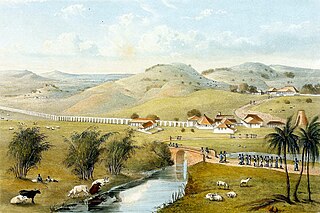
Woodlands House is a Grade II* listed Georgian villa, next door to Mycenae House, Mycenae Road, in the Westcombe Park area of the Royal Borough of Greenwich. From 1972 to 2003 the building served as a library and art museum, known as the Woodlands Art Gallery.
Estate Catherineberg is a historic mansion on Denmark Hill in Charlotte Amalie, on Saint Thomas island, in the United States Virgin Islands.
There are over 9,000 Grade I listed buildings and 20,000 Grade II* listed buildings in England. This page is a list of these buildings in the Royal Borough of Greenwich.

Nathaniel Bayly (c.1726–1798) was a West Indies plantation owner and politician who sat in the House of Commons from 1770 to 1779.
Henry James Passley was a planter and slave-owner in Jamaica. He owned Rodney Hall plantation in the parish of Portland with John Paton Passley and Richard Brown Passley. He was elected to the House of Assembly of Jamaica in 1820.
Rodney Hall plantation was located near Hope Bay in the Jamaican parish of Saint George in what is now Portland Parish. In 1809 it was in the ownership of Henry Passley who owned 140 slaves, the number rising to as high as 287 in the 1820s under different ownership. After Henry Passley, the plantation was owned by other Passleys, the Philips family, and in 1839 George Codrington. The Rodney Hall Workhouse was notorious amongst anti-slavery campaigners for its poor conditions.
Peter Robertson was a planter and slave-owner in Jamaica. He owned Dunrobin Plantation, Friendship Valley Pen, Prospect pen, and the Weybridge Estate, and had interests in others. He was elected to the House of Assembly of Jamaica in 1820 for the parish of Saint Thomas-in-the-East.
William Stimpson was a planter and slave-owner in Jamaica. He owned the Java Plantation in Manchester Parish and had interests in others. He was elected to the House of Assembly of Jamaica in 1820 for the parish of Vere.
John Williams was a planter and slave-owner in Jamaica. He owned the Cool Spring Plantation in Clarendon Parish and had an interest in Provost's Rock River plantation. He had family connections to the Isle of Wight in England. He was elected to the House of Assembly of Jamaica in 1820 for the parish of Clarendon.
John Peeke was the speaker of the House of Assembly of Jamaica in 1688 and 1706. He owned 173 slaves according to the 1708 return.
Thomas Sutton was the speaker of the House of Assembly of Jamaica in 1691-92 and 1698.
Samuel Williams Haughton (1738-1793) was the speaker of the House of Assembly of Jamaica from 1778 to 1793.

Trinity was a plantation in colonial Jamaica. It was located south of Port Maria, in Saint Mary Parish, and was one of several plantations owned by Zachary Bayly that formed part of the area known as Bayly's Vale. It employed over 1,000 slaves by the early nineteenth-century, producing mainly sugar and rum for which a mile-long viaduct was built to supply water for the refining process.

Albion' was a sugar plantation in Saint David Parish, Jamaica. Created by the 18th-century, it had at least 451 slaves when slavery was abolished in the British Empire in 1833 and by the end of the 19th-century was the most productive plantation in Jamaica due to the advanced refining technology it used. By the early 20th-century, however, its cane sugar could not compete with cheaper European beet sugar and it produced its last sugar crop in 1928. It subsequently became a banana farm for the United Fruit Company.

The West Indian Incumbered Estates Acts were Acts of the Parliament of the United Kingdom of 1854, 1858, 1862, 1864, 1872, and 1886 that allowed creditors to apply for the sale of estates (plantations) in the British colonies in the West Indies in order to receive repayment of debts despite legal obstacles that would normally prevent such a sale.
Robert Hibbert (1750-1835) was an English merchant in Kingston, Jamaica. He owned Albion plantation, owned slaves, and was a justice of the peace for Kingston, Saint George, and Saint Mary parishes.







